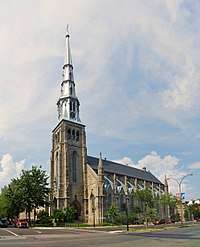Church of Saint-Pierre-Apôtre, Montreal
The Church of St. Peter the Apostle (French: Église Saint-Pierre-Apôtre) is a Canadian Roman Catholic parish church,[1] located between Boulevard René Lévesque and Rue Sainte-Catherine East, in the Village neighbourhood of Montreal, Quebec, Canada. It has been designated a Historic Place of Canada.[2]
| Church of St. Peter the Apostle | |
|---|---|
Église Saint-Pierre-Apôtre | |
 | |

| |
| Location | 120, rue de la Visitation Montreal, Quebec H2L 3B5 |
| Denomination | Catholic Church |
| History | |
| Associated people | The Rev. Father Jean-Fleury Baudrand, O.M.I. |
| Architecture | |
| Heritage designation | Registered historical site |
| Designated | 5 October 1977 |
| Architect(s) | Victor Bourgeau |
| Architectural type | Neogothic |
| Groundbreaking | 1851 |
| Completed | 1853 |
| Administration | |
| Archdiocese | Montreal |
History
Pierre Beaudry (1774–1848) (after whom the Beaudry Métro station is named) was the owner of a large farm in the suburbs of Montreal, who bequeathed a part of his land for the construction of a new church of the Diocese of Montreal to be named after his patron saint. In an effort to curb the power of the Society of Saint-Sulpice, who controlled all the parishes of the city, Ignace Bourget, the Bishop of Montreal, invited a community of the Missionary Oblates of Mary Immaculate from France, who arrived in December 1841.[3] They soon took up residence on the site, then called Faubourg Québec, opening the Maison Saint-Pierre-Apôtre, in what was fast becoming a working-class neighbourhood of the city.
Construction of a church for the community and the local people was begun in 1850, under the supervision of the Superior of the community, the Rev. Father Jean-Fleury Baudrand, O.M.I.[4] The architect was Victor Bourgeau, who was a noted ecclesiastical architect in the city, building the Basilica of Notre-Dame and St. James Cathedral in Montreal, as well as Saint-Joachim de Pointe-Claire Church in Pointe-Claire, Quebec.
A level of rivalry existed between the Sulpician and Oblate Fathers. This was especially true when the Sulpicians established Sainte-Brigide Parish in 1878, which included Saint-Pierre-Apôtre within its territory. This ended only when Saint-Pierre was established as a parish in its own right in 1900.[3]
Today the church holds the Chapel of Hope (French: Chapelle de l'Espoir), dedicated to the victims of AIDS, perhaps the only one of its kind in the world.[5]
Architecture
.jpg)
The complex to which the church belongs consists also of the rectory and sacristy, as well as a clock tower and the former choir school and elementary school.
The church has three naves, which terminate under a polygonal apse. The rectory, built 1854-1856, is of the same height as the church, built in the neoclassical style. The choir school was established in a small wooden house on the property of the Oblate community in 1859 as a private school for boys, which was replaced by the current structure in 1868. The growing need for general education led to the construction of the elementary school in 1886-1887.[3]
The original decorations of the interior of the church might have been done by Bourgeau. Later work was done by Guido Nincheri (1885-1973). The church also boasts of an organ made by Casavant Frères (opus 316) in 1908. The stained glass windows, crafted 1853-1883, were created by the House of Champigneulle, in Bar-le-Duc, France.[6]
References
- "Our Parishes: Saint-Pierre-Apôtre". The Catholic Church in Montreal.
- "Discovering the Church of Saint-Pierre-Apôtre" (PDF). Conseil du patrimoine religieux du Québec. Archived from the original (PDF) on 2014-07-14.
- "Site historique de Saint-Pierre-Apôtre". Canada's Historic Places (in French).
- "Baudrand, Fleury". Dictionary of Canadian Biography.
- "Église Saint-Pierre-Apôtre". Tourisme Montréal.
- "Église Saint-Pierre-Apôtre". Inventaire des lieux de culte du Québec (in French).
| Wikimedia Commons has media related to Église Saint-Pierre-Apôtre de Montréal. |